

 |
Search the Site with

|
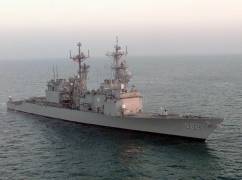 | 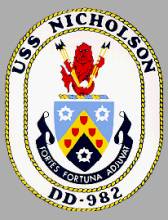 | 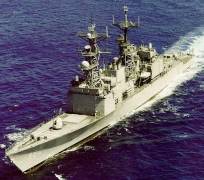 |
USS NICHOLSON was the 20th ship in the SPRUANCE class and the fourth ship in the Navy to bear the name.
Originally homeported in Charleston, S.C., as part of Destroyer Squadron 6, NICHOLSON was later transferred to Norfolk Naval Shipyard, Portsmouth, Va., as part of Destroyer
Squadron 18, and finally to Naval Station Norfolk.
Sailing on 11 deployments and wetting her keel in every ocean of the world, NICHOLSON has been awarded the Joint Meritorious Unit Award, Meritorious Unit Commendation, Navy Battle Efficiency Ribbon (five awards), National Defense Service Medal (two awards), Armed Forces Expeditionary Medal (four awards), Southwest Asia Service Medal (two awards), Sea Service Deployment Ribbon (eleven awards), Navy Arctic Service Ribbon and the Coast Guard Special Operations Service Ribbon (two awards).
On November 18, 1980, NICHOLSON started its first deployment and in 1999, she supported NATO Operation Allied Force by firing Tomahawk missiles on Yugoslav ground targets.
Decommissioned on December 18, 2002, and stricken from the Navy list on April 6, 2004, the NICHOLSON was sunk as a target on July 30, 2004.
| General Characteristics: | Awarded: January 15, 1974 |
| Keel laid: February 20, 1976 | |
| Launched: November 29, 1977 | |
| Christened: January 28, 1978 | |
| Commissioned: May 12, 1979 | |
| Decommissioned: December 18, 2002 | |
| Builder: Ingalls Shipbuilding, West Bank, Pascagoula, Miss. | |
| Propulsion system: four General Electric LM 2500 gas turbine engines | |
| Propellers: two | |
| Blades on each Propeller: five | |
| Length: 564,3 feet (172 meters) | |
| Beam: 55,1 feet (16.8 meters) | |
| Draft: 28,9 feet (8.8 meters) | |
| Displacement: approx. 9,200 tons full load | |
| Speed: 30+ knots | |
| Aircraft: two | |
| Armament: two | |
| Crew: approx. 340 |
Crew List:
This section contains the names of sailors who served aboard USS NICHOLSON. It is no official listing but contains the names of sailors who submitted their information.
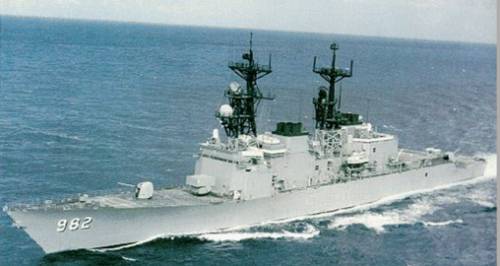
Accidents aboard USS NICHOLSON:
| Date | Where | Events |
|---|---|---|
| August 27, 2000 | 100 miles east off Norfolk, Va. | USS NICHOLSON collided with the Fast Combat Support Ship USS DETROIT (AOE 4) early Sunday night during a refueling maneuver. The destroyer sustained light damage on the port side of its helicopter hangar about 8:45 p.m. when it bumped the starboard side of the USS DETROIT (AOE 4), officials said. Damage to the Detroit was negligible, they said. A handful of sailors from the NICHOLSON suffered minor injuries, the Navy reported: an injured ankle, possible shock, an elbow injury, possible torn knee ligaments, and a head cut that required stitches. In the incident, the NICHOLSON and the DETROIT were steaming alongside each other, as is customary during a replenishment at sea. While the maneuver was described as a training session for the crews of both ships, it also involved an actual fuel transfer. No cause for the accident has been released. The weather was not a significant factor. The weather there was good at the time of the mishap, with seas 2 to 4 feet, light southeast winds and unlimited visibility. Normally, during an at-sea refueling there is a separation of 90 to 180 feet between the two ships. A refueling ship such as the DETROIT generally maintains a set course and speed while the ship being refueled approaches it from astern, then matches the refueling ship's course and speed. Fuel lines are then transferred to begin the refueling. After a similar collision with two other Navy ships just two month before some experts warned of a phenomenon called the "Venturi Effect," in which a powerful suction is created near the stern area of one ship that can pull in an overtaking vessel at close quarters, causing a collision. 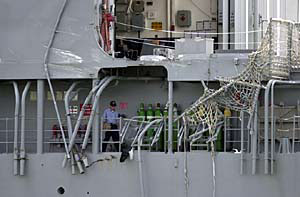 |
USS NICHOLSON Patch Gallery:
 |  |
About the Ship’s Name, about the Nicholson Family:
USS NICHOLSON is the fourth Navy ship to be named for the five members of the Nicholson family renowned in American naval history. The original three brothers, James, Samuel and John, served with great distinction during the Revolutionary War. In the next generation, John's son, William, served during both the War of 1812 and the Civil War, and likewise in the third generation, Samuel's grandson, James, served during the Civil War.
Captain James Nicholson (1737 - 1804) was the senior Continental Navy Captain in the Revolutionary War. Prior to receiving his commission in the Continental Navy, he served in the Colonial Navy with the British and was present during the assault on Havana in 1762. During the Revolutionary War, he commanded three ships of the line: DEFENSE, TURNBULL and VIRGINIA. Most notable, when his ship was blockaded at Baltimore, Captain Nicholson took his men to join Washington at Trenton, and aided in that victory.
Captain Samuel Nicholson (1732 - 1811) first served under John Paul Jones in the BON HOMME RICHARD. Later, while in command of DEAN, he brilliantly captured three British sloops-of-war. He assumed duties of Superintendent of the construction of the CONSTITUTION ("OLD IRONSIDES") and served on board as her first Commanding Officer.
Captain John Nicholson (1756 - 1844) was commissioned a Lieutenant in the Continental Navy in October 1776, and the next month was promoted to Captain to command the sloop HORNET. After the war, he was active in public affairs in the State of Maryland.
Captain William C. Nicholson (1800 - 1872) entered the Navy as a Midshipman in 1812. He served under Stephen Decatur during the War of 1812, and later commanded the steam frigate ROANOKE during the Civil War.
Admiral James W. C. Nicholson (1821 - 1887) participated in Commodore Mathew G. Perry's Japanese Expedition of 1853. During the Civil War, he commanded the ISAAC SMITH, SHAMROCK, MANHATTAN and MOHONGO. As an Admiral, he commanded a European Station from 1881 to 1883. During the British bombardment of Alexandria, Egypt in 1882, he rescued the records of the American Consulate, and evacuated many American and European officials. He received numerous commendations and awards, both at home and abroad, for his operation.
The Nicholson name was carried to sea in the service of America by either a family member or ship named for the family in each major naval conflict up to, and including, World War II. It is most appropriate that this tradition by resumed by DD 982 in a class of ships, which, for the most part, carry the names of Americans of Distinguished Naval Service.
USS NICHOLSON Image Gallery:
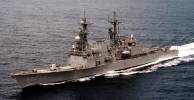 |  |  | 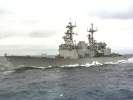 | |
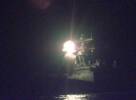 | 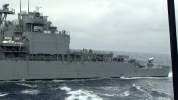 | 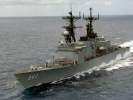 | ||
The photo below was taken by Karl-Heinz Ahles and shows USS NICHOLSON at Norfolk, Va.
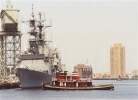 |
 Back to Destroyers list.
Back to Destroyers list.  Back to ships list.
Back to ships list.  Back to selection page.
Back to selection page.  Back to 1st page.
Back to 1st page.